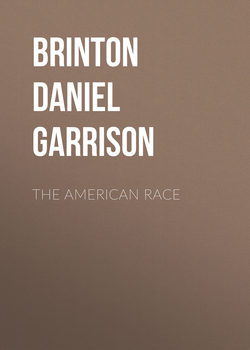Читать книгу The American Race - Daniel G. (Daniel Garrison) Brinton, Brinton Daniel Garrison - Страница 11
NORTH AMERICAN TRIBES
I. THE NORTH ATLANTIC GROUP
8. THE PAWNEES (CADDOES)
ОглавлениеThe Pani112 stock was scattered irregularly from the Middle Missouri River to the Gulf of Mexico. The Pawnees proper occupied the territory from the Niobrara River south to the Arkansas. The Arikari branch had separated and migrated to the north at a comparatively recent period, while the Wichitas, Caddoes and Huecos roamed over Eastern Louisiana and Western Texas. The earliest traditions of all these peoples assign their priscan home toward the south, and the Pawnees remembered having driven the Dakota tribes from the hunting grounds of the Platte Basin.
The stock as a rule had an excellent physique, being tall and robust, with well-proportioned features, the lips thin and the eyes small. Longevity however was rare, and few of either sex reached the age of sixty. The division of the tribes was into bands and these into totems, but the gentile system did not prevail with much strength among them. The chieftainship of the bands was hereditary in the male line, and the power of the chief was almost absolute. He was surrounded by a body of retainers whom he supported, and who carried out his orders. When he wished a council these messengers carried the summons. Property as well as power passed to the family of the male, and widows were often deprived of everything and left in destitution. Marriage was a strictly commercial transaction, the woman being bought from her parents. The purchase effected, the bridegroom had a right to espouse all the younger sisters of his wife as they grew to maturity, if he felt so inclined. The laxity of the marriage rules of the stock was carried to its limit by the Arikaris, among whom it is said fathers united with their daughters and brothers with their sisters, without offending the moral sense of the community. This may have arisen after corruption by the whites.
Agriculture among them was more in favor than generally on the plains. Maize, pumpkins and squashes were cultivated, each family having its own field two or three acres in extent. For about four months of the year they were sedentary, dwelling in houses built of poles and bark covered with sods, while the remainder of the time they wandered over their hunting grounds, carrying with them tents of skins which were stretched on poles. The women manufactured a rude pottery and the men implements and weapons of wood and stone. The Arikaris were skilled in the construction of boats of skin stretched over wooden frames, an art they may have learned from the Mandans.
The information about their religion is vague, but it seems in some respects to have resembled that of the Mexican nations. One of their chief divinities was the morning star, Opirikut, which was supposed to represent the deity of fertility and agriculture. At the time of corn-planting a young girl, usually a captive, was sacrificed to this divinity. The victim was bound to a stake and partly burned alive; but before life had ceased, her breast was cut open, her heart torn out and flung in the flames. Her flesh was then cut into small pieces and buried in the cornfield. This was believed to secure an abundant crop. The similarity of the rite to that in vogue among the Mexicans, who also worshipped the morning star as the goddess of fertility, is interesting.
The dead were buried with their possessions, and the customs of mourning continued sometimes for years.113
PANI LINGUISTIC STOCK
Anaddakkas, on left bank of Sabine river.
Arikaris, on the middle Missouri.
Assinais, in central Texas.
Caddoes, near Clear Lake, La.
Cenis, see Assinais.
Huecos, on the upper Brazos river.
Innies, see Texas.
Nachitoches, on upper Red river.
Natacos, see Anaddakkas.
Pawnees, between Niobrara and Arkansas rivers.
Tawakonies, on upper Leon river.
Texas, on upper Sabine river and branches.
Towachies, see Pawnees.
Wichitas, on north bank of Red river.
Yatasses, on Stony creek, an affluent of Red river.
112
The name Pani is not a word of contempt from the Algonkin language, as has often been stated, but is from the tongue of the people itself. Pariki means a horn, in the Arikari dialect uriki, and refers to their peculiar scalp-lock, dressed to stand erect and curve slightly backward, like a horn. From these two words came the English forms Pawnee and Arikaree. (Dunbar.)
113
The authorities on the Panis are John B. Dunbar, in the Magazine of American History, 1888; Hayden, Indian Tribes of the Missouri Valley (Philadelphia, 1862), and various government reports.
